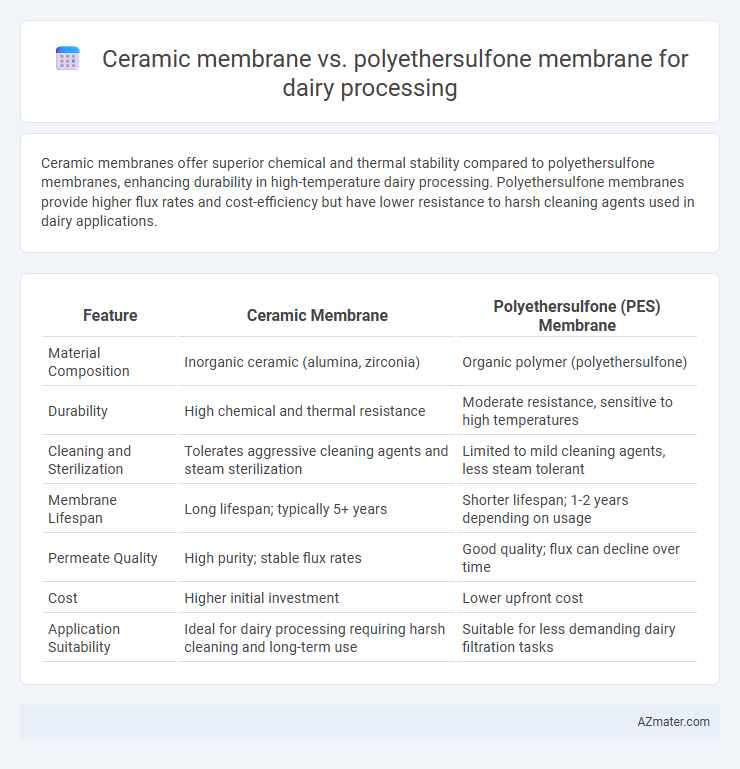Ceramic membranes offer superior chemical and thermal stability compared to polyethersulfone membranes, enhancing durability in high-temperature dairy processing. Polyethersulfone membranes provide higher flux rates and cost-efficiency but have lower resistance to harsh cleaning agents used in dairy applications.
Table of Comparison
| Feature | Ceramic Membrane | Polyethersulfone (PES) Membrane |
|---|---|---|
| Material Composition | Inorganic ceramic (alumina, zirconia) | Organic polymer (polyethersulfone) |
| Durability | High chemical and thermal resistance | Moderate resistance, sensitive to high temperatures |
| Cleaning and Sterilization | Tolerates aggressive cleaning agents and steam sterilization | Limited to mild cleaning agents, less steam tolerant |
| Membrane Lifespan | Long lifespan; typically 5+ years | Shorter lifespan; 1-2 years depending on usage |
| Permeate Quality | High purity; stable flux rates | Good quality; flux can decline over time |
| Cost | Higher initial investment | Lower upfront cost |
| Application Suitability | Ideal for dairy processing requiring harsh cleaning and long-term use | Suitable for less demanding dairy filtration tasks |
Introduction to Membrane Technologies in Dairy Processing
Ceramic membranes offer superior chemical and thermal stability compared to polyethersulfone membranes, making them ideal for dairy processing applications requiring repeated cleaning and high-temperature operations. Polyethersulfone membranes provide excellent permeability and selectivity for protein and fat separation but have lower resistance to harsh cleaning protocols. The choice between ceramic and polyethersulfone membranes hinges on processing conditions, desired filtration performance, and membrane lifespan in dairy production.
Overview of Ceramic Membranes
Ceramic membranes in dairy processing offer superior chemical and thermal resistance compared to polyethersulfone membranes, enabling prolonged use in high-temperature pasteurization and CIP (clean-in-place) operations. Their inorganic structure allows for exceptional durability and longer lifespan, making them ideal for filtration tasks involving complex dairy components like milk proteins and fats. These membranes provide high flux rates and precise pore size distribution, resulting in efficient separation and concentration of dairy products with minimal fouling.
Overview of Polyethersulfone (PES) Membranes
Polyethersulfone (PES) membranes are widely used in dairy processing due to their excellent chemical resistance, high thermal stability, and superior protein retention capabilities, making them ideal for milk filtration and whey protein concentration. These membranes exhibit hydrophilic properties that reduce fouling and ensure consistent flux rates, enhancing operational efficiency in dairy applications. Compared to ceramic membranes, PES membranes offer cost-effective solutions with flexible module designs suitable for large-scale dairy processing plants.
Filtration Efficiency: Ceramic vs PES Membranes
Ceramic membranes exhibit superior filtration efficiency in dairy processing due to their high chemical and thermal resistance, enabling effective removal of bacteria, fats, and proteins with minimal fouling. Polyethersulfone (PES) membranes offer good permeability and initial filtration performance but are prone to faster fouling and reduced lifespan when exposed to harsh cleaning chemicals and high temperatures common in dairy applications. The durability and consistent flux of ceramic membranes result in lower operational costs and higher product quality compared to PES membranes in dairy filtration processes.
Chemical and Thermal Stability Comparison
Ceramic membranes exhibit superior chemical and thermal stability compared to polyethersulfone (PES) membranes, enabling operation at higher temperatures up to 300degC and resistance to strong cleaning agents like alkalis and acids, which is essential for rigorous dairy processing sanitation. PES membranes typically withstand temperatures up to 80degC and moderate pH ranges, making them more susceptible to degradation under harsh cleaning protocols commonly required in dairy industry applications. The enhanced durability of ceramic membranes supports prolonged lifespan and consistent performance in demanding dairy filtration processes involving high-temperature pasteurization and aggressive chemical cleaning cycles.
Fouling Resistance and Cleaning Protocols
Ceramic membranes exhibit superior fouling resistance compared to polyethersulfone membranes in dairy processing, due to their smoother surfaces and higher chemical and thermal stability. Cleaning protocols for ceramic membranes typically involve aggressive cleaning agents at elevated temperatures, allowing for effective removal of protein and fat deposits without compromising membrane integrity. In contrast, polyethersulfone membranes require more frequent and milder cleaning cycles to prevent irreversible fouling, limiting their lifespan and operational efficiency in dairy applications.
Lifespan and Durability in Dairy Applications
Ceramic membranes offer superior lifespan and durability in dairy processing due to their high resistance to chemicals, thermal stability, and mechanical strength, enabling prolonged operation despite frequent cleaning cycles. Polyethersulfone (PES) membranes, while providing excellent filtration performance, typically exhibit shorter lifespans as they are more susceptible to fouling and degradation under harsh cleaning protocols common in dairy environments. The robust nature of ceramic membranes makes them ideal for long-term, high-throughput dairy applications where consistent membrane integrity and operational longevity are critical.
Cost Analysis: Initial Investment and Operational Expenses
Ceramic membranes typically demand a higher initial investment due to advanced materials and robust construction, but they offer longer lifespans and superior chemical resistance, reducing frequent replacement costs. Polyethersulfone (PES) membranes have a lower upfront cost but incur higher operational expenses because of shorter durability and increased fouling rates, requiring more frequent cleaning and membrane replacement. Evaluating total cost of ownership in dairy processing reveals ceramic membranes may provide better long-term economic efficiency despite initial capital intensity.
Product Quality and Yield Impact
Ceramic membranes offer superior chemical and thermal resistance, enabling more precise ultrafiltration that improves product quality by preserving sensitive milk proteins and enhancing microbial retention. Polyethersulfone membranes provide higher flux rates and lower fouling tendencies, resulting in increased yield and operational efficiency in dairy processing. The choice between ceramic and polyethersulfone membranes directly impacts the optimization of protein recovery and overall product consistency in milk and cheese production.
Sustainability and Environmental Considerations
Ceramic membranes offer higher chemical and thermal resistance, enabling longer operational lifespan and reducing waste generation compared to polyethersulfone membranes in dairy processing. Polyethersulfone membranes, while cost-effective and efficient in filtration, require more frequent replacement, leading to increased membrane waste and higher environmental impact. The recyclability of ceramic membranes and their compatibility with aggressive cleaning agents contribute significantly to sustainable dairy processing practices by minimizing resource consumption and operational downtime.

Infographic: Ceramic membrane vs Polyethersulfone membrane for Dairy processing
 azmater.com
azmater.com